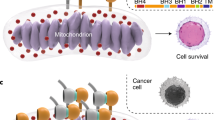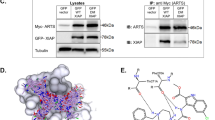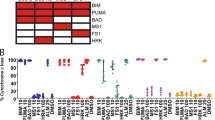Abstract
Activating the intrinsic apoptosis pathway with small molecules is now a clinically validated approach to cancer therapy. In contrast, blocking apoptosis to prevent the death of healthy cells in disease settings has not been achieved. Caspases have been favored, but they act too late in apoptosis to provide long-term protection. The critical step in committing a cell to death is activation of BAK or BAX, pro-death BCL-2 proteins mediating mitochondrial damage. Apoptosis cannot proceed in their absence. Here we show that WEHI-9625, a novel tricyclic sulfone small molecule, binds to VDAC2 and promotes its ability to inhibit apoptosis driven by mouse BAK. In contrast to caspase inhibitors, WEHI-9625 blocks apoptosis before mitochondrial damage, preserving cellular function and long-term clonogenic potential. Our findings expand on the key role of VDAC2 in regulating apoptosis and demonstrate that blocking apoptosis at an early stage is both advantageous and pharmacologically tractable.
This is a preview of subscription content, access via your institution
Access options
Access Nature and 54 other Nature Portfolio journals
Get Nature+, our best-value online-access subscription
$29.99 / 30 days
cancel any time
Subscribe to this journal
Receive 12 print issues and online access
$259.00 per year
only $21.58 per issue
Buy this article
- Purchase on Springer Link
- Instant access to full article PDF
Prices may be subject to local taxes which are calculated during checkout






Similar content being viewed by others
Data availability
All data generated or analyzed during this study are available upon request. Raw data is available for Figs. 1–6. Bax knockout and Mcl1 floxed mouse strains are available from Jackson Laboratories. All other materials generated in the course of our study will be made available upon request from the authors.
References
Roberts, A. W. et al. Targeting BCL2 with venetoclax in relapsed chronic lymphocytic leukemia. New Eng. J. Med. 374, 311–322 (2016).
Souers, A. J. et al. ABT-199, a potent and selective BCL-2 inhibitor, achieves antitumor activity while sparing platelets. Nat. Med. 19, 202–208 (2013).
Linton, S. D. Caspase inhibitors: a pharmaceutical industry perspective. Curr. Top. Med. Chem. 5, 1697–1717 (2005).
Cayrol, C. & Girard, J. P. The IL-1-like cytokine IL-33 is inactivated after maturation by caspase-1. Proc. Natl Acad. Sci. USA 106, 9021–9026 (2009).
Ekert, P. G. et al. Apaf-1 and caspase-9 accelerate apoptosis, but do not determine whether factor-deprived or drug-treated cells die. J. Cell Biol. 165, 835–842 (2004).
Kazama, H. et al. Induction of immunological tolerance by apoptotic cells requires caspase-dependent oxidation of high-mobility group box-1 protein. Immunity 29, 21–32 (2008).
Luthi, A. U. et al. Suppression of interleukin-33 bioactivity through proteolysis by apoptotic caspases. Immunity 31, 84–98 (2009).
Marsden, V. S. et al. Apoptosis initiated by Bcl-2-regulated caspase activation independently of the cytochrome c/Apaf-1/caspase-9 apoptosome. Nature 419, 634–637 (2002).
Rongvaux, A. et al. Apoptotic caspases prevent the induction of type I interferons by mitochondrial DNA. Cell 159, 1563–1577 (2014).
Suzuki, J., Denning, D. P., Imanishi, E., Horvitz, H. R. & Nagata, S. Xk-related protein 8 and CED-8 promote phosphatidylserine exposure in apoptotic cells. Science 341, 403–406 (2013).
White, M. J. et al. Caspases render apoptosis immunologically silent by suppressing mtDNA-induced STING-mediated type I IFN production. Cell 159, 1549–1562 (2014).
Dixit, V. M. & O’Brien, T. in Cell Death (eds G. Melino & D. Vaux) 282–291 (John Wiley & Sons, 2010).
Wei, M. C. et al. Proapoptotic BAX and BAK: a requisite gateway to mitochondrial dysfunction and death. Science 292, 727–730 (2001).
Lindsten, T. et al. The combined functions of proapoptotic Bcl-2 family members bak and bax are essential for normal development of multiple tissues. Mol. Cell 6, 1389–1399 (2000).
Willis, S. N. et al. Proapoptotic Bak is sequestered by Mcl-1 and Bcl-xL, but not Bcl-2, until displaced by BH3-only proteins. Genes Dev. 19, 1294–1305 (2005).
Ryan, J. & Letai, A. BH3 profiling in whole cells by fluorimeter or FACS. Methods 61, 156–164 (2013).
Mason, K. D. et al. Programmed anuclear cell death delimits platelet life span. Cell 128, 1173–1186 (2007).
Motoyama, N. et al. Massive cell death of immature hematopoietic cells and neurons in Bcl-x-deficient mice. Science 267, 1506–1510 (1995).
Veis, D. J., Sorenson, C. M., Shutter, J. R. & Korsmeyer, S. J. Bcl-2-deficient mice demonstrate fulminant lymphoid apoptosis, polycystic kidneys, and hypopigmented hair. Cell 75, 229–240 (1993).
Alsop, A. E. et al. Dissociation of Bak alpha1 helix from the core and latch domains is required for apoptosis. Nat. Commun. 6, 6841 (2015).
Griffiths, G. J. et al. Cellular damage signals promote sequential changes at the N-terminus and BH-1 domain of the pro-apoptotic protein Bak. Oncogene 20, 7668–7676 (2001).
Brouwer, J. M. et al. Bak core and latch domains separate during activation, and freed core domains form symmetric homodimers. Mol. Cell 55, 938–946 (2014).
Dewson, G. et al. To trigger apoptosis, Bak exposes its BH3 domain and homodimerizes via BH3:groove interactions. Mol. Cell 30, 369–380 (2008).
Ma, S. B. et al. Bax targets mitochondria by distinct mechanisms before or during apoptotic cell death: a requirement for VDAC2 or Bak for efficient Bax apoptotic function. Cell Death Differ. 21, 1925–1935 (2014).
Wei, M. C. et al. tBID, a membrane-targeted death ligand, oligomerizes BAK to release cytochrome c. Genes Dev. 14, 2060–2071 (2000).
Iyer, S. et al. Bak apoptotic pores involve a flexible C-terminal region and juxtaposition of the C-terminal transmembrane domains. Cell Death Differ. 22, 1665–1675 (2015).
Moldoveanu, T. et al. BID-induced structural changes in BAK promote apoptosis. Nat. Struct. Mol. Biol. 20, 589–597 (2013).
Brouwer, J. M. et al. Conversion of Bim-BH3 from activator to inhibitor of bak through structure-based design. Mol. Cell 68, 659–672 (2017).
Jiang, X. et al. A small molecule that protects the integrity of the electron transfer chain blocks the mitochondrial apoptotic pathway. Mol. Cell 63, 229–239 (2016).
Yamamoto, T. et al. VDAC1, having a shorter N-terminus than VDAC2 but showing the same migration in an SDS-polyacrylamide gel, is the predominant form expressed in mitochondria of various tissues. J. Proteome Res. 5, 3336–3344 (2006).
Cheng, E. H., Sheiko, T. V., Fisher, J. K., Craigen, W. J. & Korsmeyer, S. J. VDAC2 inhibits BAK activation and mitochondrial apoptosis. Science 301, 513–517 (2003).
Roy, S. S., Ehrlich, A. M., Craigen, W. J. & Hajnoczky, G. VDAC2 is required for truncated BID-induced mitochondrial apoptosis by recruiting BAK to the mitochondria. EMBO Rep. 10, 1341–1347 (2009).
Lazarou, M. et al. Inhibition of Bak activation by VDAC2 is dependent on the Bak transmembrane anchor. J. Biol. Chem. 285, 36876–36883 (2010).
Naghdi, S., Varnai, P. & Hajnoczky, G. Motifs of VDAC2 required for mitochondrial Bak import and tBid-induced apoptosis. Proc. Natl Acad. Sci. USA 112, E5590–E5599 (2015).
Kollek, M. et al. Transient apoptosis inhibition in donor stem cells improves hematopoietic stem cell transplantation. J. Exp. Med. 214, 2967–2983 (2017).
Kostic, V., Jackson-Lewis, V., de Bilbao, F., Dubois-Dauphin, M. & Przedborski, S. Bcl-2: prolonging life in a transgenic mouse model of familial amyotrophic lateral sclerosis. Science 277, 559–562 (1997).
Nir, I., Kedzierski, W., Chen, J. & Travis, G. H. Expression of Bcl-2 protects against photoreceptor degeneration in retinal degeneration slow (rds) mice. J. Neurosci. 20, 2150–2154 (2000).
Reyes, N. A. et al. Blocking the mitochondrial apoptotic pathway preserves motor neuron viability and function in a mouse model of amyotrophic lateral sclerosis. J. Clin. Invest. 120, 3673–3679 (2010).
Someya, S. et al. Age-related hearing loss in C57BL/6J mice is mediated by Bak-dependent mitochondrial apoptosis. Proc. Natl Acad. Sci. USA 106, 19432–19437 (2009).
Wei, Q., Dong, G., Chen, J. K., Ramesh, G. & Dong, Z. Bax and Bak have critical roles in ischemic acute kidney injury in global and proximal tubule-specific knockout mouse models. Kidney Int. 84, 138–148 (2013).
Chen, Z. Y., Chua, C. C., Ho, Y. S., Hamdy, R. C. & Chua, B. H. L. Overexpression of Bcl-2 attenuates apoptosis and protects against myocardial I/R injury in transgenic mice. Am. J. Physiol. Heart Circul. Physiol. 280, H2313–H2320 (2001).
Hotchkiss, R. S. et al. Overexpression of Bcl-2 in transgenic mice decreases apoptosis and improves survival in sepsis. J. Immunol. 162, 4148–4156 (1999).
Zhao, H., Yenari, M. A., Cheng, D. Y., Sapolsky, R. M. & Steinberg, G. K. Bcl-2 overexpression protects against neuron loss within the ischemic margin following experimental stroke and inhibits cytochrome c translocation and caspase-3 activity. J. Neurochem. 85, 1026–1036 (2003).
Ben-Hail, D. et al. Novel compounds targeting the mitochondrial protein VDAC1 inhibit apoptosis and protect against mitochondrial dysfunction. J. Biol. Chem. 291, 24986–25003 (2016).
Niu, X. et al. A small-molecule inhibitor of bax and bak oligomerization prevents genotoxic cell death and promotes neuroprotection. Cell Chem. Biol. 24, 493–506.e495 (2017).
Garner, T. P. et al. Small-molecule allosteric inhibitors of BAX. Nat. Chem. Biol. 15, 322–330 (2019).
Ren, D. et al. The VDAC2-BAK rheostat controls thymocyte survival. Sci. Signal. 2, ra48 (2009).
Chin, H. S. et al. VDAC2 enables BAX to mediate apoptosis and limit tumor development. Nat. Commun. 9, 4976 (2018).
Skwarczynska, M. & Ottmann, C. Protein-protein interactions as drug targets. Future Med. Chem. 7, 2195–2219 (2015).
Kabsch, W. Xds Acta Crystallogr. D 66, 125–132 (2010).
McCoy, A. J. et al. Phaser crystallographic software. J. App. Cryst. 40, 658–674 (2007).
Emsley, P. & Cowtan, K. Coot: model-building tools for molecular graphics. Acta Crystallogr. D 60, 2126–2132 (2004).
Adams, P. D. et al. PHENIX: a comprehensive python-based system for macromolecular structure solution. Acta Crystallogr. D 66, 213–221 (2010).
Schirle, M., Bantscheff, M. & Kuster, B. Mass spectrometry-based proteomics in preclinical drug discovery. Chem. Biol. 19, 72–84 (2012).
Delconte, R. B. et al. CIS is a potent checkpoint in NK cell-mediated tumor immunity. Nat. Immunol. 17, 816–824 (2016).
Kedzierski, L. et al. Suppressor of cytokine signaling (SOCS)5 ameliorates influenza infection via inhibition of EGFR signaling. Elife 6, e20444 (2017).
Cox, J. et al. Andromeda: a peptide search engine integrated into the MaxQuant environment. J. Proteome Res. 10, 1794–1805 (2011).
Rautela, J. et al. Generation of novel Id2 and E2-2, E2A and HEB antibodies reveals novel Id2 binding partners and species-specific expression of E-proteins in NK cells. Mol. Immunol. https://doi.org/10.1016/j.molimm.2018.08.017 (2018).
Vizcaino, J. A. et al. 2016 update of the PRIDE database and its related tools. Nucleic Acids Res. 44, D447–D456 (2016).
Acknowledgements
We thank R. Youle (National Institute of Neurological Disorders and Stroke, Bethesda, USA) for providing HCT116 cells, L. Whitehead (The Walter and Eliza Hall Institute, Melbourne, Australia) for assistance with image analysis and the many other colleagues who have shared reagents and contributed to discussions throughout this project. We are grateful for the outstanding animal husbandry provided by The Walter and Eliza Hall Institute Bioservices staff, and expert assistance from the Institute’s Flow Cytometry Facility. This research was undertaken in part using the MX2 beamline at the Australian Synchrotron. Our work was supported by project grants (nos. 1083077 to G.L. and M.F.vD., 1078924 to G.D. and A.W., 1158137 to G.L., P.E.C. and M.F.vD.), program grants (nos. 461219 to B.T.K., 461221 to D.C.S.H. and P.M.C., 1016701 to D.C.S.H. and P.M.C., 1016647 to B.T.K., 1113133 to D.C.S.H., P.M.C. and G.L.), fellowships (nos. 1024620 to E.L., 1022618 to P.M.C., 1079700 to P.E.C., 1043149 to D.C.S.H., 1117089 to G.L. and 1063008 to B.T.K.) and an Independent Research Institutes Infrastructure Support Scheme grant (no. 9000220) from the Australian National Health and Medical Research Council; Additional funding was provided by MuriGen Therapeutics to B.T.K. and D.C.S.H.; by the HEARing CRC to B.T.K. and G.L.; by the DHB Foundation to B.T.K and G.L.; by the Brownless Trust to B.T.K. and G.L.; a fellowship from the Sylvia and Charles Viertel Foundation to B.T.K.; the Australian Cancer Research Fund and a Victorian State Government Operational Infrastructure support grant.
Author information
Authors and Affiliations
Contributions
B.T.K., D.C.S.H. initiated the project. B.T.K., D.C.S.H. M.F.v.D. and G.L. designed and coordinated the study. G.D., K.L., P.E.C., P.M.C. W.D.F., E.F.L. and K.G.W. advised on various aspects of the study. G.L. supervised the medicinal chemistry team. Y.K., C.T.B., C.G., P.P.S., S.D., R.L., S.B., L.P., T.N., K.G.W. and G.L. designed and/or prepared compounds. A.W. produced protein for structural biology studies. J.M.B, P.M.C. and P.E.C. performed structural biology studies. K.N.L., C.M., S.S.W. and K.L. designed and performed high-throughput screening and assay support. M.F.v.D., M.A.D, L.L. K.McA., M.-X.L, H.S.C., W.D.F., E.L., D.S. and G.D. performed cell and molecular biology experiments. S.C. and R.M.L. performed mouse ex vivo experiments. C.G. performed UV crosslinking experiments. L.F.D., J.J.S. and A.I.W. designed and performed proteomics analysis. B.T.K, G.L. and M.F.v.D wrote the manuscript with major input from D.C.S.H., G.D., K.L., P.E.C., P.M.C and K.G.W. as well as all other authors. B.T.K., D.C.S.H., G.L. and M.F.v.D. acquired funding for this study.
Corresponding authors
Ethics declarations
Competing interests
B.T.K. was a consultant to MuriGen Pty Ltd between 2006 and 2010.
Additional information
Publisher’s note Springer Nature remains neutral with regard to jurisdictional claims in published maps and institutional affiliations.
Supplementary information
Supplementary Information
Supplementary Figures 1–19 and Supplementary Tables 1–3.
Synthetic procedures
Synthetic procedures
Supplementary Dataset 1
iBAQ intensities for proteins identified by compound 7 affinity purification.
Supplementary Dataset 2
iBAQ intensities for proteins identified by compound 8 photocrosslinking, biotinylation and streptavidin capture.
Rights and permissions
About this article
Cite this article
van Delft, M.F., Chappaz, S., Khakham, Y. et al. A small molecule interacts with VDAC2 to block mouse BAK-driven apoptosis. Nat Chem Biol 15, 1057–1066 (2019). https://doi.org/10.1038/s41589-019-0365-8
Received:
Accepted:
Published:
Issue Date:
DOI: https://doi.org/10.1038/s41589-019-0365-8
This article is cited by
-
A novel inhibitory BAK antibody enables assessment of non-activated BAK in cancer cells
Cell Death & Differentiation (2024)
-
Mechanisms of BCL-2 family proteins in mitochondrial apoptosis
Nature Reviews Molecular Cell Biology (2023)
-
Mitochondrial E3 ubiquitin ligase MARCHF5 controls BAK apoptotic activity independently of BH3-only proteins
Cell Death & Differentiation (2023)
-
Pore-forming proteins as drivers of membrane permeabilization in cell death pathways
Nature Reviews Molecular Cell Biology (2023)
-
Mitochondrial outer membrane permeabilization at the single molecule level
Cellular and Molecular Life Sciences (2021)



